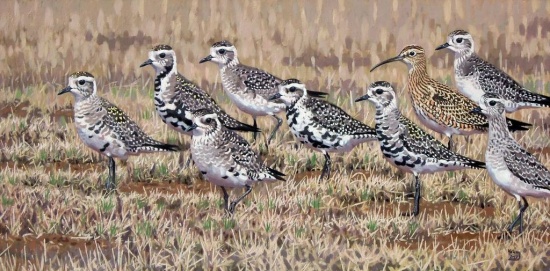(Artwork added. References updated) |
|||
| (16 intermediate revisions by 8 users not shown) | |||
| Line 1: | Line 1: | ||
| − | {{ | + | {{extinct?}} |
| − | ;Numenius borealis | + | [[Image:Eszkim 3.jpg|thumb|550px|right|A single Eskimo Curlew in the flock of [[American Golden Plover]]s<br />Artwork by {{user|Szabi|Szabi}}]] |
| + | ;[[:Category:Numenius|Numenius]] borealis | ||
| + | ==Identification== | ||
| + | 30cm. | ||
| + | *Brown with white specks | ||
| + | *Cinnamon underwings | ||
| − | |||
| − | |||
==Distribution== | ==Distribution== | ||
| − | + | Probably extinct. Bred [[Canada|Canadian]] Arctic; wintered to southern [[South America]]. | |
| + | ====History==== | ||
| + | *In the 1800s, large numbers wintered in south-central [[South America]], migrating via north-east [[North America]] and south on the Atlantic coast. Vagrants were recorded in [[Greenland]] and northern [[Siberia]], also on the [[Falkland Islands]]. In the Western [[Palearctic]] vagrants were recorded from September to October in [[Ireland]] and [[Britain]] (last in 1887). Whether extinct or supported by an infinitesimally sized population, chance of future transatlantic vagrancy is virtually null. | ||
| + | *No authenticated records since the early 1960s. Thought by some to still survive in very small numbers, unconfirmed reports have continued into the 21st century - both on wintering grounds and along former migration routes. Virtually all of these reports relate to single birds, save one observer's unsupported claim to flocks numbering 20-150 individuals (citation needed). | ||
| − | + | ==Taxonomy== | |
| + | This is a [[Dictionary_M-O#M|monotypic]] species<sup>[[#References|[1]]]</sup>. | ||
| − | |||
| − | |||
| − | |||
==Habitat== | ==Habitat== | ||
Bred on Arctic tundra, otherwise on natural grassland or farmland. | Bred on Arctic tundra, otherwise on natural grassland or farmland. | ||
| − | |||
==Behaviour== | ==Behaviour== | ||
| − | == | + | ====Diet==== |
| − | + | The diet included insects such as grasshoppers. | |
| − | + | ==References== | |
| + | #{{Ref-Clements6thAug16}} | ||
| + | {{ref}} | ||
==External Links== | ==External Links== | ||
| − | + | {{GSearch|Numenius+borealis}} | |
| − | [[Category:Birds]] [[Category:Missing Images]] | + | An authentic photograph and information is available here: |
| + | *[http://www.tpwd.state.tx.us/huntwild/wild/species/eskcurl/ Texas Parks and Wildlife: Eskimo Curlew] | ||
| + | [[Category:Birds]] [[Category:Numenius]] [[Category:Artwork Only]] [[Category:Missing Images]] [[Category:Citation needed]] | ||
Latest revision as of 23:35, 23 May 2017

|
The species Eskimo Curlew is possibly extinct. |

|
- Numenius borealis
Identification
30cm.
- Brown with white specks
- Cinnamon underwings
Distribution
Probably extinct. Bred Canadian Arctic; wintered to southern South America.
History
- In the 1800s, large numbers wintered in south-central South America, migrating via north-east North America and south on the Atlantic coast. Vagrants were recorded in Greenland and northern Siberia, also on the Falkland Islands. In the Western Palearctic vagrants were recorded from September to October in Ireland and Britain (last in 1887). Whether extinct or supported by an infinitesimally sized population, chance of future transatlantic vagrancy is virtually null.
- No authenticated records since the early 1960s. Thought by some to still survive in very small numbers, unconfirmed reports have continued into the 21st century - both on wintering grounds and along former migration routes. Virtually all of these reports relate to single birds, save one observer's unsupported claim to flocks numbering 20-150 individuals (citation needed).
Taxonomy
This is a monotypic species[1].
Habitat
Bred on Arctic tundra, otherwise on natural grassland or farmland.
Behaviour
Diet
The diet included insects such as grasshoppers.
References
- Clements, J. F., T. S. Schulenberg, M. J. Iliff, D. Roberson, T. A. Fredericks, B. L. Sullivan, and C. L. Wood. 2016. The eBird/Clements checklist of birds of the world: v2016, with updates to August 2016. Downloaded from http://www.birds.cornell.edu/clementschecklist/download/
Recommended Citation
- BirdForum Opus contributors. (2024) Eskimo Curlew. In: BirdForum, the forum for wild birds and birding. Retrieved 20 May 2024 from https://www.birdforum.net/opus/Eskimo_Curlew
External Links
An authentic photograph and information is available here:




